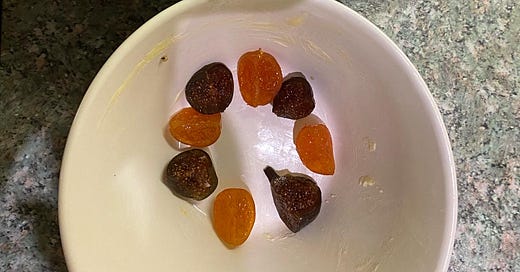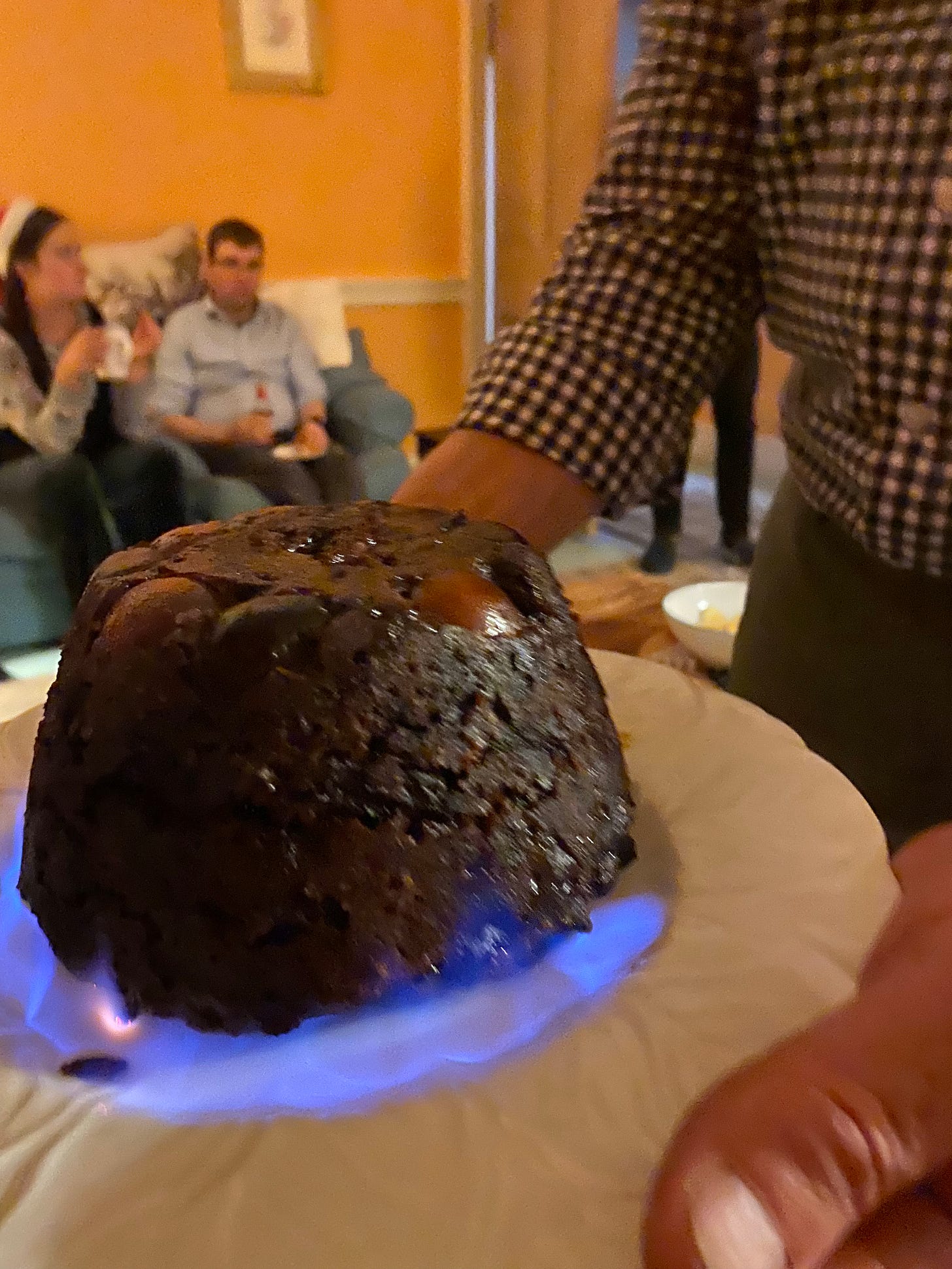The Sunday before Advent (the twenty fifth Sunday after Trinity) has since Victorian times, been known as Stir Up Sunday. This Sunday goes hand-in-wooden spoon with stirring up a Christmas Pudding.
‘Stir up, we beseech thee, O Lord the wills of thy faithful people’ comes from the Collect in the Book of Common Prayer. It is translated from a Latin collect commencing ‘Excita’, meaning stir up.
Figgy Pudding is an interesting name for a traditionally, bomb-shaped pudding because the recipe rarely contains fig, although the dried fruits will have been well doused with alcohol, usually brandy. The pudding was originally made with beef and mutton mixed with raisins, prunes, alcohol and spices; a sort of meat broth thickened with bread. At some point vegetables, grains, fats, spices and raisins and currants were added. The exact contents varied according to affluence. Poorer families used shavings of suet, grains, pulses and herbs, whilst richer families enjoyed meat and expensive imported fruits. The fruit was not plums. The Plum pudding or pottage (boiled in a pot) was packed into animal stomach and kept for a later feast.
In the carol ‘We Wish you a Merry Christmas’, the carollers sing ‘Oh, bring us some figgy pudding’, and then almost threateningly, ‘We won’t go until we get some’. It was something carol singers thought worth eating. Figgy pudding demands patience, slow cooking and then a good month of resting for the flavours to mature. Suet is a useful ingredient in that it melts when cooked and thereby ensures that when eaten hot, the pudding is moist. However, it is high in calories. A post war (01:12:46) article in the British Medical Journal suggests that the average Figgy Pudding calorie intake per person numbers 2750. Consolingly the article states that we should worry not because ‘its sustenance is of the mind not body.’ ‘A particularly fine recipe will be hailed as evidence of an art now lost, like that of colouring mediaeval cathedral glass.’ There is also mention of the delight in finding a dusty cookery book with an egg-stained recipe – a defiant reaction to wartime rationing when carrots were used to pad out ration book hoarded, dried fruits. The article stressed the cultural qualities of Christmas pudding: brandy from France, lemons from the Levant, almonds from Italy, sugar from the Caribbean rather than nutritional concern. Reference is made to the writer Dr Johnson who stated in his book The History of Rasselas, Prince of Abissinia (1759), ‘Human life is everywhere a state in which much is to be endured and little enjoyed’. The nutritional analysis of Christmas pudding puts it in danger of being forbidden, but it is eaten on a feast day, so I say, ‘Bravo Figgy Pudding.’
In 1644, Parliament under the Puritans, banned maypoles and fairs. Christmas, closely associated with Catholicism, was to be spent in contemplation not merriment and feasting. To many, Christmas had become a debauched affair. Oliver Cromwell believed that Christmas excess encouraged immortality. Scottish Presbyterians had already set a precedent by banning the Christmas festival earlier, in 1640. On Christmas day soldiers patrolled the streets of the cities and seized any festive food. New Year’s Day and Candlemas (2nd February) remained festive days. The Christmas ban was removed in 1660 with the Restoration. Mincemeat pies avoided the ban because at this time the recipe called for meat not dried fruits. Indeed, my grandmothers 1934 collection of mincemeat recipes, includes a recipe that uses hard boiled eggs. There was a preference for Mutton or mutton suet in mincemeat recipes, in remembrance of the shepherds of Bethlehem – although beef suet was often more accessible.
In researching Christmas Pudding recipes, I’ve found that dried fruit is the main ingredient. The other ingredients are sparse, and their main role seems to be to bind the fruits together. Older recipes that include stoning and chopping raisins and grating the suet are more laborious. However, I suggest that it is worth using freshly grated suet. This may not be on display but is usually available from a local butcher – grating suet is an easy task. In Mrs Beeton’s Book of Household Management there is a plain Christmas recipe for children that uses milk instead of alcohol, but it is nevertheless rich in fruits and suet. Interestingly, Mrs Beeton has a selection of both Plum and Christmas pudding recipes with little noticeable change in ingredients. Stir Up Sunday lends itself to family involvement. Tradition says that each person stirs the pudding mixture with eyes tightly closed and makes a wish. Margaret Baker writing in Folklore and Customs of Rural England says that in Sussex on Stir Up Sunday, the pudding was stirred sunwise three-times-three with a wooden spoon (recalling the wooden manager) and as the family stirred, in decreasing order of seniority, they would wish three times. Sadly, only one wish would be granted. This was an inclusive act in that the pudding was then set aside to await absentee family members. Christmas pudding benefits from standing so this may even have improved its flavour.
This dark, rich fruit pudding has the weeks of Advent (coming) to mature. Advent brings the start of the Church’s year as centred on the life of Jesus Christ - a time of expectancy and of waiting at the darkest time of the year when there is little to forage on the hedgerow. In the Northern Hemisphere, the cook, following the church’s calendar through the seasons, will be relieved that Christmas recipes use dried and preserved ingredients - Plum Pudding and Mincemeat tick the seasonal box.







Lovely reminiscence, Fiona, thank you! Mincemeat, made with real minced meat, is utterly forgotten on this side of the Atlantic. I made it once only, about 50 or 60 years ago in, of all places, Beirut, Lebanon, where it was easy to obtain all the ingredients. The recipe came from the venerable James Beard who had published it in the old Gourmet magazine. I let it sit for the required number of weeks then made it into hand pies. They were not universally successful, being a little too rich and strange for modern palates--even back then in the dark ages.
Separating suet (floury fingers) and de-pipping raisins (warm water for rinsing sticky fingers) - ah yes, I remember it well...